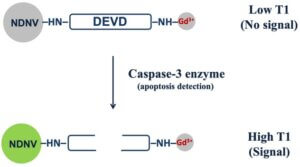Summary
Chemotherapy is limited by the failure to clinically monitor the efficacy of the treatment in real-time, which results in suboptimal chemotherapy being given for a prolonged period. Predicting the outcome of chemotherapy immediately after drug administration can increase diagnostic accuracy, efficacy outcomes, and successful treatment. Quantum nanodiamond sensors can be used as optical sensors and drug delivery probes for chemotherapy. In particular, nanodiamonds containing nitrogen-vacancy (NV) centers can serve as attractive probes for optically sensing chemical reactions and biological processes, thanks to their small size, bio-compatibility, and fluorescent properties of the NV centers. This work focuses on variations in the relaxation time in the nanodiamond NV centers, which change when the nanodiamonds are brought into proximity to Gadolinium (Gd) ions – for example, by using a peptide sequence as a connector between the nanodiamond and a Gd compound – and can be optically monitored. The experiment will investigate one type of action of chemotherapeutic drugs, which is to induce cell death (apoptosis) of the cancer cells. Specific enzymes released during apoptosis can cut the connection between the nanodiamonds and Gd, separating NVs from the Gd and decreasing the relaxation rate. Thus, observing the differences in relaxation rate upon chemotherapy allows the drug’s efficacy to be immediately monitored.

Figure 1. A specific enzyme (Caspase 3) is released in the presence of an effective chemotherapeutic drug, resulting in the separation of nanodiamonds and Gd and decreasing the relaxation rate.
Related Content

Quantum Information Processing with Molecular Lattices
The aim of the work is to develop theoretical tools to simulate and predict the behaviour of a one-dimensional chain of trapped dipolar molecules and to study the nature of entanglement as a design resource.
June 1, 2017

Mesoscopic systems as coherent control elements
Summary Mesoscopic systems provide a new tool for quantum systems design. In particular, they are enabling of robust quantum control. Here “mesoscopic system” refers to a connected network where each element, if studied alone, would be a quantum bit. The network is too big to be treated fully quantum mechanically. We do not have individual […]
September 1, 2016

Scanning Tunneling Microscopy of Quantum Materials, Devices and Molecules
Summary This project advances our ability to characterize and study novel quantum materials, quantum devices, and even individual molecules at the atomic level. By combining Non-Contact Atomic Force Microscopy (NC-AFM), Scanning Tunneling Microscopy (STM) and scanning gate methods, we correlate spatial information with transport properties and can locally manipulate charge, spin and structural states. […]
January 28, 2019

Zero-Dimensional Quantum Materials for the Next Generation of Highly-Selective Chemical Sensors
Summary Heavy metals are a major public health concern and their on-site detection in water supplies is not well served by existing lab techniques. We develop a new multi-modal platform comprising functionalized quantum dots of two-dimensional materials (2D-QDs) for the sensing of four highly-toxic heavy metal pollutants (arsenic, cadmium, lead and mercury). The zero-dimensional […]
March 11, 2019

